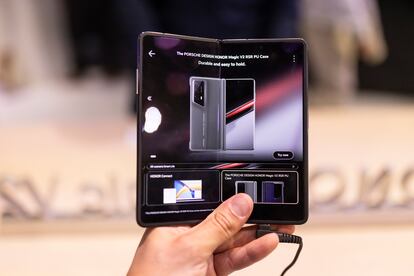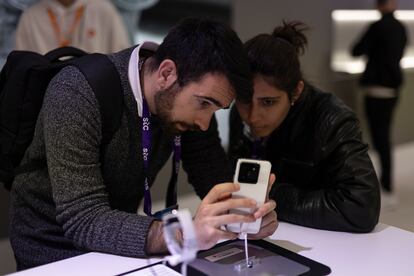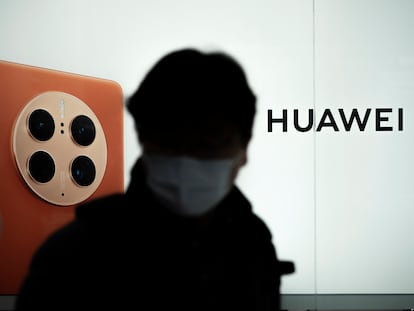Foldable models, artificial intelligence and other MWC proposals to boost cell phone sales
At the Mobile World Congress, the eagerness of smartphone brands to find new products to boost sales after two years of decline is evident

The fact that the Mobile World Congress (MWC) in Barcelona is not what it used to be was apparent in previous editions. This is also because the smartphone industry is not the same as it once was. After a spike in 2021, due to pent-up demand during the peak of the pandemic, in 2022 the market experienced a 12% drop, according to Canalys data. Last year, 1.14 billion units were sold, representing a decrease of 4%. The decline is easing, but not stopping, and manufacturers are struggling to devise formulas for renewing sales.
Integrating artificial intelligence into devices or the launch of foldable formats are some of the trends featured in the smartphones at this year’s MWC. This has been a rather watered-down trade fair in terms of new products, as many of the devices on display have previously been presented. The jostling that manufacturers used to engage in to launch the most spectacular handset of the event has become a kind of universal retreat. Not even the promise of global limelight — much of the world’s tech press attends the trade fair — serves as an incentive for brands.
Xiaomi has been the only major manufacturer to launch its high-end range, although this was preceded by a presentation in China. In its devices, it is the camera that takes center stage. Thanks to a partnership with Leica, the Xiaomi 14 features quad and triple lenses, designed to provide versatility when shooting in different scenarios, in poor lighting conditions, distant, very close or moving targets. Artificial intelligence (AI) is not missing when it comes to taking photos or editing them.
However, the introduction of AI in camera function enhancement has been on the market for some time now. Namely, since 2017, when Google introduced it in its Pixel 2 as an ideal complement to the lens hardware. These had started to increase in numbers a year earlier, with the Huawei P9, which featured dual sensors. This had all been in place for some time. The novelty consisted of supplementing what already existed from year to year.
The new AI wave
In addition to photography, the new AI wave, known as ‘generative AI’ and is driven by models such as GPT or Gemini, looks set to be a major industry game changer. The analyst firm Counterpoint forecasts that 100 million smartphones with this technology will be sold by 2024. By 2027 there will be 522 million units, representing 40% of the total.

The first models are on display at MWC 2024. The Samsung Galaxy S24, as previously seen in its presentation, boasts multiple options supported by AI. It allows you to optimize photos, removing reflections, blurring in editing or filling backgrounds through pixel generation. In addition, it features tools for transcribing an audio file, summarizing an article from any website or translating it easily. Samsung has invited EL PAÍS to the trade fair.
Galaxy AI technology, which will be available in March for the Galaxy S23 and is expected to be introduced in subsequent versions, differs from the artificial intelligence of other handsets in terms of certain functionalities. It provides simultaneous translation of a phone call conversation and makes it easy to find contextual information about any object on the screen by circling over it.
Honor has showcased its Magic6 Pro at MWC, unveiled previously in China, and announced its international launch. It is now on sale and incorporates the Llama 2 AI model (developed by Meta), which provides answers, similar to the way ChatGPT does, and lets you create texts. Its camera function also features artificial intelligence. It possesses an algorithm that predicts movement and makes it easier to capture ultra-high-definition images. Its three cameras feature a 180-megapixel telephoto lens, 2.5x optical zoom and 100x digital zoom.
Foldable models take center stage
MWC 2024 also embraces the trend of showcasing foldable smartphones. Initiated by Samsung with its Galaxy Z Fold5 and Galaxy Z Flip5, the trend has been adopted by many manufacturers. Motorola, Huawei, Oppo and Google itself have launched their hinge-included mobiles. In 2023, Counterpoint estimated that 16.7 million of these devices would be sold, representing only 1.5% of the total market. However, this year it expects a jump to 30.6 million devices, accounting for 2.6% of the market share.

Sales may be low, but they are gradually increasing and companies are targeting this niche, which is small in terms of units but lucrative when it comes to profit margins. Also unveiled at MWC 2024 is the Honor Magic V2 RSR, with its Porsche Design version, which boasts a 6.43-inch screen, resolution of 2376x1060 pixels and a refresh rate of 120 Hz. When you open it, the 7.9-inch interior panel appears, with a resolution of 2344x2156 pixels and also at 120 Hz. This is a two-in-one model, smartphone and tablet at the same time, with a design modeled on the Porsche 911 and a bulky price, even for a folding device, of €2,699.
Also on display at the fair is ZTE’s first foldable mobile, the Nubia Flip 5G. It features a 6.9-inch internal display, which is slightly larger than that of a large smartphone. When folded, it looks like a phone from the early 2000s, with a keyboard that pops out when opened. It has a 120 Hz panel refresh rate and a dual camera with 50 megapixels per lens. At the ZTE display, they confirm that it will go on sale in Europe between March and April and will retail from €599 ($650). This will make it one of the cheapest foldable phones on the market.
Extra incentive
As an added attraction, some brands are banking on alliances in the design of their handsets to bolster sales. While Honor has a partnership with Porsche Design, HMD, owner of the Nokia brand, has announced a collaboration with the toy company Mattel. Out of this will come, riding on the success of the 2023 movie, a Barbie-themed cell phone. There is not much more information on this, but the manufacturer intends to team up with other consumer brands to produce more designs along these lines.
Meanwhile, TCL is aiming to attract consumers through affordability. It has unveiled three handsets for under €250 ($270). The cheapest of them all, the TCL 505, boasting a 6.75-inch screen, 128 GB of storage and a 50-megapixel dual camera, costs €109 ($218).
This year, there is not much more in terms of devices at MWC. Some mobile brands, like Oppo, have significantly reduced their participation for this edition, while others, such as Huawei, remain focused on the Chinese market. Smartphones are now showing signs of burnout. Brands have ridden a wave that was thought to be infinite, but has ebbed away like all waves. At present, it remains stranded on the shore, in anticipation of new developments, something that has not quite caught the eye this year.
Sign up for our weekly newsletter to get more English-language news coverage from EL PAÍS USA Edition
Tu suscripción se está usando en otro dispositivo
¿Quieres añadir otro usuario a tu suscripción?
Si continúas leyendo en este dispositivo, no se podrá leer en el otro.
FlechaTu suscripción se está usando en otro dispositivo y solo puedes acceder a EL PAÍS desde un dispositivo a la vez.
Si quieres compartir tu cuenta, cambia tu suscripción a la modalidad Premium, así podrás añadir otro usuario. Cada uno accederá con su propia cuenta de email, lo que os permitirá personalizar vuestra experiencia en EL PAÍS.
¿Tienes una suscripción de empresa? Accede aquí para contratar más cuentas.
En el caso de no saber quién está usando tu cuenta, te recomendamos cambiar tu contraseña aquí.
Si decides continuar compartiendo tu cuenta, este mensaje se mostrará en tu dispositivo y en el de la otra persona que está usando tu cuenta de forma indefinida, afectando a tu experiencia de lectura. Puedes consultar aquí los términos y condiciones de la suscripción digital.
More information

A perfect storm hits Samsung
Archived In
Últimas noticias
Mustafa Suleyman: ‘Controlling AI is the challenge of our time’
Venezuela breaks energy agreements with Trinidad and Tobago due to alleged complicity with the US
The murder of Michele and Rob Reiner: A tale of horrific days in Hollywood
Trump orders a ‘complete blockade of sanctioned oil tankers’ going to and from Venezuela
Most viewed
- ‘El Limones’ and the growing union disguise of Mexican organized crime
- Christian Louboutin: ‘Young people don’t want to be like their parents. And if their parents wear sneakers, they’re going to look for something else’
- ‘We are dying’: Cuba sinks into a health crisis amid medicine shortages and misdiagnosis
- A mountaineer, accused of manslaughter for the death of his partner during a climb: He silenced his phone and refused a helicopter rescue
- The low-cost creative revolution: How technology is making art accessible to everyone









































